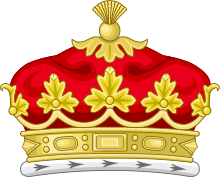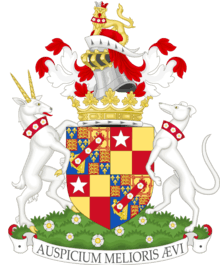Duke of St Albans
Duke of St Albans is a title in the Peerage of England. It was created in 1684 for Charles Beauclerk, 1st Earl of Burford, then fourteen years old. King Charles II had accepted that Burford was his illegitimate son by Eleanor Gwynn (commonly known as 'Nell'), an actress, and awarded him the Dukedom just as he had conferred the Dukedoms of Monmouth, Southampton, Grafton, Northumberland and Richmond and Lennox on his other illegitimate sons.
| Dukedom of St Albans | |
|---|---|
 _2e_duc_de_Saint-Albans.svg.png) Arms of Murray de Vere Beauclerk, 14th Duke of St Albans: Grand quarterly, 1st and 4th grand quarters: the Royal Arms of Charles II, viz quarterly: 1st and 4th, France and England quarterly; 2nd, Scotland; 3rd, Ireland; the whole debruised by a baton sinister gules charged with three roses argent barbed and seeded proper (Lennox[1]); 2nd and 3rd grand quarters: quarterly gules and or, in the first quarter a mullet argent (De Vere). (Arms of the 2nd Duke onwards) | |
| Creation date | 10 January 1684 |
| Monarch | Charles II |
| Peerage | Peerage of England |
| First holder | Charles Beauclerk, 1st Duke of St Albans |
| Present holder | Murray Beauclerk, 14th Duke |
| Heir apparent | Charles Beauclerk, Earl of Burford |
| Remainder to | the 1st Duke's heirs male of the body lawfully begotten |
| Subsidiary titles | Earl of Burford Baron Heddington Baron Vere |
| Motto | Auspicium melioris aevi ("A pledge of better times")[2] |
The subsidiary titles of the Duke are: Earl of Burford, in the County of Oxford (1676), Baron Heddington, in the County of Oxford (1676) and Baron Vere, of Hanworth in the County of Middlesex (1750). The Earldom and the Barony of Heddington are in the Peerage of England, and the Barony of Vere is in the Peerage of Great Britain. The Dukes of St Albans also bear the hereditary title of Grand Falconer of England, and Hereditary Registrar of the Court of Chancery.
The eldest son and heir of the Duke of St Albans is known by the courtesy title Earl of Burford, and Lord Burford's eldest son and heir is known as Lord Vere.
Recent Dukes of St Albans have not held a landed estate. Former seats of the Dukes of St Albans were Bestwood Lodge in Nottinghamshire, now a hotel,[3] and Upper Gatton Park in Surrey.[4]
The accepted pronunciation of the family surname Beauclerk is reflected in the original alternative rendering Beauclaire: boh-clair.[5]
Dukes of St Albans (1684)

- Other titles: Earl of Burford, in the county of Oxford, and Baron Heddington, in the county of Oxford (1676)
- Charles Beauclerk, 1st Duke of St Albans (1670–1726) (elder illegitimate son of Charles II and Nell Gwynn)
- Charles Beauclerk, 2nd Duke of St Albans (1696–1751) (eldest son of the 1st Duke)
- George Beauclerk, 3rd Duke of St Albans (1720–1786) (only son of the 2nd Duke, died without issue)
- George Beauclerk, 4th Duke of St Albans (1758–1787) (grandson of Lord William Beauclerk, second son of the 1st Duke, died unmarried)
- Other titles (5th Duke onwards): Baron Vere, of Hanworth in the county of Middlesex (1750)
- Aubrey Beauclerk, 5th Duke of St Albans (1740–1802) (fourth and youngest son of Vere Beauclerk, 1st Baron Vere, himself third son of the 1st Duke)
- Aubrey Beauclerk, 6th Duke of St Albans (1765–1815) (eldest son of the 5th Duke)
- Aubrey Beauclerk, 7th Duke of St Albans (1815–1816) (only son of the 6th Duke, died in infancy)
- William Beauclerk, 8th Duke of St Albans (1766–1825) (second son of the 5th Duke)
- William Aubrey de Vere Beauclerk, 9th Duke of St. Albans (1801–1849) (eldest son of the 8th Duke)
- William Amelius Aubrey de Vere Beauclerk, 10th Duke of St Albans (1840–1898) (only son of the 9th Duke)
- Charles Victor Albert Aubrey de Vere Beauclerk, 11th Duke of St Albans (1870–1934) (eldest son of the 10th Duke, died without issue)
- Osborne de Vere Beauclerk, 12th Duke of St Albans (1874–1964) (second son of the 10th Duke, died without issue)
- Charles Frederick Aubrey de Vere Beauclerk, 13th Duke of St Albans (1915–1988) (grandson of Lord Charles Beauclerk, fifth son of the 8th Duke)
- Murray de Vere Beauclerk, 14th Duke of St Albans (b. 1939) (eldest son of the 13th Duke)
The heir apparent is Charles Francis Topham de Vere Beauclerk, Earl of Burford (b. 1965) (only son of the 14th Duke).
The heir apparent's heir apparent is his only son, James Malcolm Aubrey Edward de Vere Beauclerk, Lord Vere (b. 1995).
Barons Vere (1750)
- Vere Beauclerk, 1st Baron Vere (1699–1781) (third son of the 1st Duke)
- Aubrey Beauclerk, 2nd Baron Vere (1740–1802) (succeeded as 5th Duke of St Albans in 1787)
for subsequent Barons Vere see Dukes of St Albans above
Line of succession
- Charles Francis Topham de Vere Beauclerk, Earl of Burford (b. 1965) (only son of the 14th Duke)
- James Malcolm Aubrey Edward de Vere Beauclerk, Lord Vere (b. 1995) (only son of Lord Burford)
- Lord Peter Charles de Vere Beauclerk (b. 1948) (second son of the 13th Duke)
- Tenzin Beauclerk (b. 2005) (younger but only surviving son of Lord Peter)
- Lord James Charles Fesq de Vere Beauclerk (b. 1949) (third son of the 13th Duke)
- Lord John William Aubrey de Vere Beauclerk (b. 1950) (youngest son of the 13th Duke)
- William Rafael Beauclerk, Marques de Valero de Urria (great-great-great-great-grandson of Lord Sidney Beauclerk, fifth son of the 1st Duke)
- Alexander Charles Beauclerk (b. 1990) (elder son of the Marques de Valero de Urria)
- Cameron Beauclerk (b. 1993) (younger son of the Marques de Valero de Urria)
Only those at positions 1 to 6 are in remainder to the Barony of Vere.
Arms
 |
|
Family tree
See also
Notes
- The Scottish Earldom of Lennox had merged into the crown on the accession of King James I & VI, whose father Henry Stewart, Lord Darnley was the heir presumptive to that earldom, the king was thus at liberty to re-award the Lennox arms, or versions of them, as he pleased
- Debrett's Peerage, 1876, p.411
- Sale brochure for Upper Gatton Park, June 2016.
- British Museum – Madame Ellen Groinn
References
- An Online Gotha - St Albans
- Leigh Rayment's Peerage Pages
- Charles Kidd & David Williamson (ed.), Debrett's Peerage and Baronetage (1990 edition), New York: St Martin's Press, 1990,
Further reading
- Donald Adamson and Peter Beauclerk Dewar, The House of Nell Gwyn. The Fortunes of the Beauclerk Family, 1670-1974, London: William Kimber, 1974